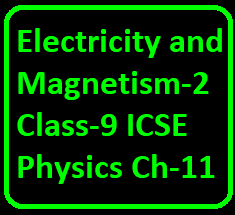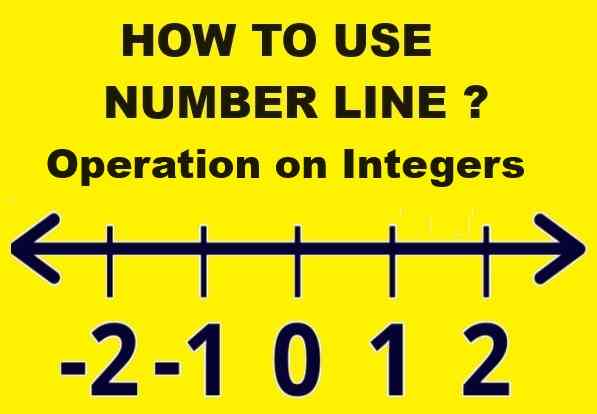Goyal Brothers Electricity and Magnetism-2 Class-9 ICSE Physics Ch-11. We Provide Step by Step Answer of Exercise, Subjective and MCQs of Goyal Brothers Electricity and Magnetism-2 and Practices for Conservation of Resources Class-9 ICSE Physics Ch-11, Visit official Website CISCE for detail information about ICSE Board Class-9 Physics.
Goyal Brothers Electricity and Magnetism-2 Class-9 ICSE Physics Ch-11
-: Select Topic :-
Exercise Objective Questions
Goyal Brothers Electricity and Magnetism-2 Class-9 ICSE Physics Ch-11
Multiple Choice Questions.
Select the correct option:
1. A bar magnet is rubbed on a bar of steel along its length 20 times. The bar of steel gets magnetised due to the process of :
(a) induction
(b) conduction
(c) friction
(d) none of the these
2.The magnetic strength of a bar magnet is :
(a) maximum at its centre
(b) same along the magnet
(c) maximum near its ends
(d) none of these
3. The surest test of magnet is :
(a) repulsion
(b) attraction
(c) induction
(d) none of these
4. Nickel is a :
(a) ferromagnetic substance
(b) paramagnetic substance
(c) diamagnetic substance
(d) none of these
5. The substance which form a strong temporary magnet is:
(a) steel
(b) platinum
(c) soft iron
(d) manganese
6. The place around a magnet where its influence can be detected is called :
(a) magnetic lines of force
(b) magnetic pole
(c) magnetic field
(d) magnetic space
Exercise Subjective Questions
Goyal Brothers Electricity and Magnetism-2 Class-9 ICSE Physics Ch-11
Question 1.
What do you meant by the term pole of a magnet? Magnetically speaking, what is the difference between a piece of brass, a piece of soft iron and a piece of lode- stone?
Answer:
Pole of a magnet: Each end of a bar magnet is called its pole. The point situated slightly inside a bar magnet, where most of its magnetic power is concentrated, is called magnetic pole or pole of a magnet.
Brass is not a magnetic substance and it is not affected by magnetic field. It does not stick to a magnet.
Soft iron is a ferromagnetic substance and gets strongly attracted towards a magnet. Soft iron can not attract other magnetic substances unless gets magnetised.
Lode stone is naturally magnetized piece of mineral magnetite. It can attract other magnetic substance.
Question 2. ( Goyal Brothers Electricity and Magnetism-2 Class-9 )
(a) What are magnetic and non-magnetic substances? Give at least two examples of each.
(b) Fill the blank spaces in the table given below :

Answer:
(a) Magnetic substance : Those substances which are affected by the magnetic field are known as magnetic substances.
For example : Iron, nickel, cobalt etc. are the magnetic substances.
Non-magnetic substances : Those substance which are not affected by the magnetic field are known as nonmagnetic substances.
For example : Paper, glass, wood etc.

Question 3.
Define : magnetic field, magnetic meridian, geographical meridian, declination and magnetic equator.
Answer:
Magnetic field : The space surrounding a magnet within which the magnet has its influence is called magnetic field.
Magnetic meridian: The vertical plane containing the magnetic axis of a free suspended magnet at rest, under the action of magnetic intensity of earth is called magnetic meridian. Geographical meridian : The vertical plane which contains geographical north and south poles of earth at a given place is called geographical meridian.
Decimation : The phenomenon due to which the earth’s geographical meridian is inclined to earth’s magnetic meridian is called declination.
Magnetic equator : An imaginary line right bisecting the effective length of bar magnet is called magnetic equator.
Question 4.
Define : Isogonic line, agonic line isoclinic line.
Answer:
Isogonic lines : A line which joins all the places on earth, having same angle of declination is called isogonic line.
Agonic line: A line which joins all the places on earth, having zero angle of declination is called agonic line.
Isoclinic line : A line joining all the places on globe, having same angle of dip or inclination is called isoclinic line.
Question 5.
State briefly (a) the molecular theory of magnetism, (b) the modern views on magnetism.
Answer:
(a) Ewing suggested the molecular theory of magnetism as , follows:
- Each molecule of a magnetic substance, whether it is magnetised or unmagnetised, is an independent magnet.
- In a magnetised substance, the molecules are arranged in an order so as to produce an external effect. In this order, all the north poles of the molecules of the magnetised substances point to one direction and all their south poles point to a direction opposite to that to which their north poles points.

- In an unmagnetised substance, the molecules are not arranged in any order, so they neutralise the magnetic forces of each other.

- The molecular theory of magnetism was a considerable step forward but later there came an electrical explanation for the magnetism of atoms.
Atoms consist of negatively charged particles (electrons) which revolve around the positively changed nucleus. Electrical current loops are formed in an atom due to the circulation of these electrons. Each current loop behaves a magnetic dipole and hence produce magnetic field. Also electrons are also spinning like tops and this adds further magnetism to the atom.
Question 6.
Describe various methods of magnetising a piece of iron.
Answer:
METHODS OF MAGNETISATION :
- Single Touch Method : The specimen to be magnetised is placed flat on the table. A permanent bar magnet is taken and its one pole is placed on one end of the piece. The bar magnet is then drawn to the other end, keeping it in the inclined position as shown in figure. The permanent magnet is then lifted and the process is repeated several times. The specimen is then turned over and the other side is also magnetised in the same way.
The specimen gets magnetised. Its starting end gets the same polarity as the polarity of the magnet touching it. The polarity at the other end of the specimen is opposite to that of the magnetising pole.

- Divided Touch Method: The specimen to be magnetised is placed flat on a table. Opposite poles of two strong bar magnets of equal strength are placed together in the middle of the specimen. The ends of bar magnets are drawn towards the opposite ends of the specimen, keeping the bar magnets inclined as shown in figure. The magnets are then lifted. The operation is repeated several times

The specimen is then turned over and the other side is also magnetised in the same way. The end of the specimen where the south pole of the bar magnet leaves, becomes north pole. Similarly, the end of the specimen where the north pole of the bar magnet leaves, becomes south pole. For strong magnetisation, the two ends of the specimen are supported on teh two poles of two other bar magnets, such that the pole of each magnet being the same as that of the stroking magnet over it. - Double Touch Method : This method is almost similar to the divided touch method. The only difference is that a piece of wood or cork is placed between the two opposite poles of the permanent magnets. The magnets are then moved together from the middle to the one end and then to the other end without lifting them from the specimen as shown in figure. This process is repeated several times.
The polarities on the end of the specimen are of the opposite nature to that of the nearer poles of stroking magnets figure. For strong magnetisation, the specimen is mounted on two permanent bar magnets as mentioned in the divided touch method.

- Electrical Method of Magnetisation : The specimen to be magnetised is placed inside a long coil of insulated copper wire. A strong direct current is passed through the coil for some time, when the specimen is magnetised.
If the specimen is a steel bar, it becomes a permanent magnet. However, if the specimen is a soft iron bar, it becomes a strong magnet, but it retains the properties of magnetism only so long as the current is passed through the coil. As soon as the current is stopped, it loses its magnetism.
The magnet formed by the passage of electric current by using soft iron core is called electromagnet.

Question 7. ( Goyal Brothers Electricity and Magnetism-2 Class-9 )
What is magnetic induction? Explain it giving a suitable experiment.
Answer:
Magnetic induction :
The Phenomenon due to which a piece of steel or iron behaves like a magnet when placed near a strong magnet is called magnetic induction.
Experiment : Take a freely suspended magnetic needle and bring near its south pole, the south end of a bar magnet. The needle gets longer affects the south and of magnetic needle as shown in figure (a).

Place a flat piece of iron AB, in between the bar magnet and magnetic needle. It is observed that south end of needle is repelled. Remove the iron piece AB. It is observed that needle . comes back to its original position. Repeat the experiment, but remove bar magnet instead of iron piece. We will observe that needle does not get repelled and remains continuously in its original position.
From this experiment, it is clear that soft iron piece behaves as a magnet only when a bar magnet is placed near it, when a bar magnet is removed then soft iron piece loses its magnetism.
Question 8.
Repulsion is a surer test of magnetic condition of a body than attraction. Explain.
Answer:
Repulsion is the surest test of magnetism because the attraction can be caused between two unlike poles of the two magnets or between the magnet and magnetic substance such as iron, nickel etc. But repulsion is caused when two similar poles approach each other.
Question 9.
Give short account of the earth’s magnetic field.
Answer:
When a bar magnet is suspended freely, then it aligns itself along geographical north-south direction i.e. north pole of the magnet points towards the geographical north and south pole of the magnet points towards geographical south direction. William Gilbert suggest that earth itself behaves as a huge magnet. It was assumed that:
- A huge magnet is bured at the centre of earth.
- The south end of earth’s magnet is towards the earth’s geographic north and vice-versa.
- The axis of earth’s magnet is not in line with the geographical axis, but makes a small angle with it.
The diagram on next page show the earth as a magnet and the magnetic lines of force around it

Question 10.
Give the various methods for demagnetising a magnet.
Answer:
- A magnet can be damagnetised by any of the following methods:
Electrical Method : An insulated copper coil is wound around a card board tube and inside it is placed a permanent bar magnet. The coil is placed in East-West direction and its ends are connected to a step-down transformer. The alternating current is switched on for one minute, then the bar magnet gets demagnetised.

Reason : When the current rapidly changes the direction in the insulated copper coil, the polarity set up in the coil also rapidly changes. This in turn acts inductively on the bar magnet, whose molecular magnets rapidly try to align themselves with the changing magnetic polarity. Thus, molecular magnets form closed chains and hence, the bar magnet gets demagnetised. - By Rough Handling : When a magnet is rough-handled (i.e. it is allowed to drop repeatedly) or hammered, it gets completely demagnetised.
Reason : In a bar magnet the molecular magnets are arranged in straight line chains. On hammering or rough handling, they gain kinetic energy and vibrate rapidly about their mean positions. In doing so they form closed magnetic chains and hence, the magnetism is lost. - By Heating : When a magnet is heated to red hot temperature and then allowed to cool, it loses its magnetism. Reason : Due to heat energy, the kinetic energy of the molecules increases. Thus, from straight line molecular chains, they form closed molecular chains and hence, the magnetism is lost.
- By Induction : When a given magnet is placed in contact with another similar magnet (i.e., the other magnet should be of same strength), such that their similar poles are facing each others then both the magnets get demagnetised in a couple of days.
Reason: It is because both the magnets will induce opposite polarity in each other. In doing so the molecular magnets in each magnet form closed molecular chains and hence, they get demagnetised. - By Self-Induction : A single bar magnet has a tendency to lose its magnetism.
Reason : In a bar magnet the molecular magnets (dipoles) are arranged in straight line chains. However, two or more parallel chains have their north and south poles facing each other. Thus, dipoles act inductively on each other and hence, turn to form closed molecular chains. Thus, single bar magnet gets demagnetised.
Question 11. ( Goyal Brothers Electricity and Magnetism-2 Class-9 )
The figure shows a freely suspended magnet in rest position. Copy the diagram and on it show :
(a) Angle of declination
(b) Angle in dip

Answer:

Question 12.
(a) Since every iron atom is a tiny magnet, why are not all iron bar magnets?
(b) If a magnet is carefully broken into two pieces as shown in figure (i), how does the magnetic strength of each piece compare with that of original magnet? If another magnet is carefully broken in half along its long axis shown in figure (ii), how would the strength of each piece compare with that of original magnet?
Answer:
(a) Each molecule of a magnetic substance is an independent magnet. But in an unmagnetised iron piece, molecular/ atoms (tiny magnets) are not arranged in any order and hence they neturalise the magnetic forces of each other As a result, any unmagnetised iron piece can not behave as a magnet.
(b)
- When a magnet is cut into two equal parts as shown in figure (i), then pole strength of each piece remains same as that of original magnet.
- When a magnet is cut into two equal parts as shown in figure (ii), then pole strength of each pole is half as that of the pole strength of original magnet.

Question 13. ( Goyal Brothers Electricity and Magnetism-2 Class-9 )
Draw the magnetic flux pattern near a bar magnet placed with its axis in the magnetic meridian and the south pole pointing towards geographic north.
Answer:

Question 14.
Draw a clearly labelled diagram, to show how a steel bar is magnetised by a divided touch method. A written description is not required.
Answer:

Question 15.
Define the terms magnetic declination and dip with reference to freely suspended magnet.
(a) What do you understand by the terms magnetic meridian and geographic meridian?
(b) At what places on the earth will the angle of dip be (1) maximum and (2) minimum?
Answer:
Magnetic declination : The angle through which freely suspended magnetic needle is inclined to the geographic axis is known as magnetic declination.
OR
The angle between the geographic meridian and magnetic meridian it is given place is called declination.
Magnetic dip : The angle between the horizontal axis passing through freely suspended magnet and the direction of earth’s magnetic field is called magnetic dip.
(a) Magnetic meridian : The vertical plane containing the magnetic axis of a freely suspended magnet at rest, under the action of magnetic intensity of earth is called magnetic meridian.
Geographic meridian : The vertical plane which contains geographic north and south pole of earth at a given place is called geographic meridian.
(b) The angle of dip is maximum e. 90° at the magnetic poles. The angle of dip is minimum i.e. 0° at the magnetic equator.
Question 16.
(a) What are magnetic keepers? What are they used for?
(b) Explain the ‘molecular theory’ of magnetism with the help of a diagram.
Answer:
(a) Magnetic keeper : A magnetic keeper is a ferromagnetic bar made from soft iron or steel, which is placed across the poles of a permanent magnet.Magnetic keepers are used to preserve the strength of the magnet by completing the magnetic circuit.
(b) Ewing suggested the molecular theory of magnetism as follows:
- Each molecule of a magnetic substance, whether it is magnetised or unmagnetised, is an independent magnet.
- In a magnetised substance, the molecules are arranged in an order so as to produce an external effect. In this order, all the north poles of the molecules of the magnetised substances point to one direction and all their south poles point to a direction opposite to that to which their north poles points.

- In an unmagnetised substance, the molecules are not arranged in any order, so they neutralise the magnetic forces of each other.

Question 17. ( Goyal Brothers Electricity and Magnetism-2 Class-9 )
What do you understand by the term magnetic declination?
Answer:
Magnetic declination : The angle through which freely suspended magnetic needle is inclined to the geographic axis is known as magnetic declination.
OR
The angle between the geographic meridian and magnetic meridian it is given place is called declination.
Magnetic dip : The angle between the horizontal axis passing through freely suspended magnet and the direction of earth’s magnetic field is called magnetic dip.
(a) Magnetic meridian : The vertical plane containing the magnetic axis of a freely suspended magnet at rest, under the action of magnetic intensity of earth is called magnetic meridian.
Geographic meridian: The vertical plane which contains geographic north and south pole of earth at a given place is called geographic meridian.
(b) The angle of dip is maximum i. e. 90° at the magnetic poles. The angle of dip is minimum i.e. 0° at the magnetic equator.
-: End of Goyal Brothers Electricity and Magnetism-2 Class-9 ICSE Physics Ch-11:-
Return to — Goyal Brothers ICSE Physics Class-9
Thanks




